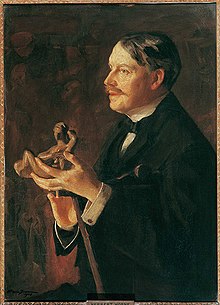Herbert Percy Horne
Herbert Percy Horne (born February 18, 1864 in London , United Kingdom, † April 14, 1916 in Florence ) was an English poet, architect, art historian and art collector who had his collection of around 6,000 works of Florentine art from the 13th to 16th centuries Century in a foundation from which the Museo Horne in Florence emerged.
Life and activities
Horne was an oddly versatile universal genius. Born in London as the eldest son of Horace Horne and Luisa Harmale, he was a precocious child and already showed his keen interest in art at the Kensington Grammar School in London, encouraged by understanding teachers. In 1880 he got to know the writings of WH Pater, especially the Studies in the history of the Renaissance (1873) fascinated him.
In 1882 he began to work as an employee in the architecture studio of AH Mackmurdo, whose partner he was between 1885 and 1890. Together with Mackmurdo, he founded the art magazine The Century Guild Hobby Horse , on which such well-known authors as Oscar Wilde and John Ruskin collaborated. During these years he developed his graphic talent, which he used as a type designer and typographer. In the context of Arts & Crafts, he dealt not only with fonts, but also with all manual pages of graphic design, drew wallpapers, book covers and bookplates.

He provided engravings for The Studio magazine in 1893 and designed the entire layout of Burlington Magazine in 1903 .
A decisive step in his development was the first trip to Italy in 1889, a second followed in 1894. The strong affinity to the Italian Renaissance was also evident in his own buildings: such as the Chapel of the Ascension in Baywater, decorated by his friend Frederic Shields (1894 completed), the Baptistery of Saint Luke at Camberwell (1899) and the library of the Positivist Church of Humanity on Chapel Street. All of these structures were destroyed in World War II.
Finally in 1905 he finally settled in Italy and made contact with the community of art historians in Florence such as Aby Warburg and Bernard Berenson . He devoted himself to an avid and extremely quality-conscious collector's activity, the result of which in the end comprised around six thousand pictures, 5000 books, including valuable incunabula , and a myriad of documents from the centuries that interested him: from the 13th to the 16th century. In 1911 he bought a palazzo in the center of Florence and restored it.
To finance his passion for collecting, he worked as a consultant for the National Gallery and the New York Metropolitan Museum , as an art critic and broker of antiques.
On April 12, 1916 he made his will and donated his collections to the Italian state, the Palazzo "with everything in it, nothing excluded". Two days later, Horne died of tuberculosis, seriously ill. His palace is now the seat of the Fondazione Horne and the Museo Horne . Horne is buried in the Cimitero Evangelico agli Allori in Galluzzo, a southern suburb of Florence.
Fonts (selection)
- Hobby Horse. Quarterly visual arts journal, edited by Horne. Chiswick Press, 1884-1894 (English)
- The Binding of Books. An Essay in the History of Gold-Tooled Bindings. London 1894
- Giovanni dal Ponte. 1906.
- Alessandro Filipepi, commonly called Sandro Botticelli, painter of Florence. 1908; New edition: Princeton University Press 1981, ISBN 978-0691039497 (English)
- Cronaca e notiziario della Rassegna d'arte antica e moderna , III, in Pagine d'Arte , ed. together with M. Logan Berenson. (1916)
For Burlington Magazine he wrote a large number of articles on Paolo Uccello , Benozzo Gozzoli , Leonardo da Vinci and Botticelli.
Remarks
- ^ Ian Fletcher: Rediscovering Herbert Horne: Poet, Architect, Typographer, Art Historian. British Authors Series, 1880–1920, London 2011, ISBN 978-094431027
- ↑ This and most of the other biographical information comes from the Enciclopedia Treccani, Elisabetta Nardinocchi: Horne, Herbert Percy. Dizionario biografico degli Italiani, Volume 61, 2004, accessed on May 20, 2018 . as well as the literature listed below.
- ↑ Herbert Percy Horne. Klingspor-Museum Offenbach, accessed on May 20, 2018 .
- ^ Edward Chaney and Jane Hall: Herbert Horne's 1889 Diary of his first Journey to Italy. In: The Walpole Society. Volume LXIV, London 2002, pp. 69-125.
- ^ Margaretta S. Frederick: On Frederic Shields' Chapel of the Ascension, 1887-1910. Branch, accessed May 21, 2018 .
- ↑ collezione. Museo Horne, accessed May 21, 2018 .
- ↑ Palazzo Corsi. Museo Horne, accessed May 21, 2018 .
- ^ Brenda Preyer: Il palazzo Corsi Horne: dal diario di restauro di HP Horne. Istituto Poligrafico e Zecca dello Stato, Rome 1993.
literature
- Elisabetta Nardinocchi: Horne, Herbert Percy. Dizionario biografico degli Italiani, Volume 61, 2004, accessed on May 20, 2018 .
- Herbert Percy Horne. Klingspor-Museum Offenbach, accessed on May 20, 2018 .
- Elisabetta Nardinocchi (Ed.): Itinerari nella casa fiorentina del Rinascimento. Fondazione Herbert P. Horne, Florence 1994.
| personal data | |
|---|---|
| SURNAME | Horne, Herbert Percy |
| BRIEF DESCRIPTION | British art historian and art collector |
| DATE OF BIRTH | February 18, 1864 |
| PLACE OF BIRTH | London |
| DATE OF DEATH | April 14, 1916 |
| Place of death | Florence |

